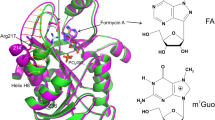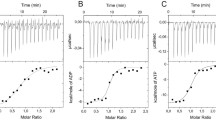Abstract
The photoaffinity spin-labeled ATP analog, 2-N3-SL-adenosine triphosphate (ATP), was used to covalently modify isolated β-subunits from F1-ATPase of the thermophilic bacterium PS3. Approximately 1.2 mol of the nucleotide analog bound to the isolated subunit in the dark. Irradiation leads to covalent incorporation of the nucleotide into the binding site. ESR spectra of the complex show a signal that is typical for protein-immobilized radicals. Addition of isolated α-subunits to the modified β-subunits results in ESR spectra with two new signals indicative of two distinctly different environments of the spin-label, e.g., two distinctly different conformations of the catalytic sites. The relative ratio of the signals is approx 2∶1 in favor of the more closed conformation. The data show for the first time that when nucleotides are bound to isolated β-subunits, binding of α-subunits induces asymmetry in the catalytic sites even in the absence of the γ-subunit.
Similar content being viewed by others
References
Abrahams, J. P., Leslie, A. G., Lutter, R., and Walker, J. E. (1994) Structure at 2.8 Å resolution of F1-ATPase from bovine heart mitochondria. Nature 25, 621–628.
Abrahams, J. P., Buchanan, S. K., Van Raaij, M. J., Fearnley, J. M., Leslie, A. G., and Walker, J. E. (1996) The structure of bovine F1-ATPase complexed with the peptide antibiotic efrapeptin. Proc. Natl. Acad. Sci. USA. 93, 9420–9424.
van Raaij, M. J., Abrahams, J. P., Leslie, A. G., and Walker J. E. (1996) The structure of bovine F1-ATPase complexed with the antibiotic inhibitor aurovertin B. Proc. Natl. Acad. Sci. USA. 93, 6913–6917.
Bianchet, M. A., Hullihen, J., Pedersen, P. L., and Amzel, L. M. (1998) The 2.8-A structure of rat liver F1-ATPase: configuration of a critical intermediate in ATP-synthesis/hydrolysis. Proc. Natl. Acad. Sci. USA. 95, 11065–11070.
Duncan, T. M., Bulygin, V. V., Zhou, Y., Hutcheon, M. L. and Cross, R. L. (1995) Rotation of subunits during catalysis by Escherichia coli F1-ATPase. Proc. Natl. Acad. Sci USA. 92, 10964–10968.
Sabbert, D., Engelbrecht, S., and Junge, W. (1996) Intersubunit rotation in active F1-ATPase. Nature 381, 623–625.
Noji, H., Yasuda, R., Yoshida, M., and Kinosita, K. Jr. (1997) Direct observation of the rotation of F1-ATPase. Nature 386, 299–302.
Shirakihara, Y., Leslie, A. G., Abrahams, J. P., et al. (1997) The crystal structure of the nucleotide-free α3β3-subcomplex of F1-ATPase from the thermophilic Bacillus PS3 is a symmetric trimer. Structure 15, 825–836.
Kersten, M. V., Dunn, S. D., Wise, J. G., and Vogel, P. D. (2000) Site-directed spin-labeling of the catalytic sites yields insight into structural changes within the F0F1-ATP synthase of Escherichia coli. J. Biol. Chem. 39, 3856–3860.
Boyer, P.D. (1993) The binding change mechanism for ATP synthase-some probabilities and possibilities. Biochim. Biophys. Acta 1140, 215–250.
Burgard, S., Nett, J. H., Sauer, H. E., Kagawa, Y., Schäfer, H.-J., Wise, J. G., Vogel, P. D., and Trommer, W. E. (1994) Effects of magnesium ions on the relative conformation of nucleotide binding sites of F1-ATPase as studied by electron spin resonance spectroscopy. J. Biol. Chem. 269, 17815.
Lösel, R. M., Erbse, A. H., Nett, J. H., Wise, J. G., Berger, G., Girault, G., and Vogel, P. D. (1996) Investigating the structure of nucleotide binding sites on the chloroplast F1-ATPase using electron spin resonance spectroscopy. Spectrochimica Acta, Part A 52, 73–83.
Lösel, R. M., Wise, J. G., and Vogel, P. D. (1997) Asymmetry of catalytic but not of noncatalytic sites on Escherichia coli F1-ATPase in solution as observed using electron spin resonance spectroscopy. Biochemistry 35, 1188–1193.
Vogel, P. D. (2000) Insights into the ATP synthase structure and function using affinity and site-specific spin-labeling. J. Bioenergetics Biomembranes 32, 413–421.
Vogel, P. D., Nett, J. H., Sauer, H. E., Schmadel, K., Cross, R. L., and Trommer, W. E. (1992) Nucleotide binding sites on mitochondrial F1-ATPase. Electron spin resonance spectroscopy and photolabeling by azido-spin-labeled adenine nucleotides support an adenylate kinase-like orientation. J. Biol. Chem. 267, 11982–11986.
Garin, J., Boulay, F., Issartel, J. P., Lunardi, J., and Vignais, P. V. (1986) Identification of amino acid residues photolabeled with 2-azido[α-32P]adenosine diphosphate in the β-subunit of beef heart mitochondrial F1-ATPase. Biochemistry 25, 4431–4437.
Cross, R. L., Cunningham, D., Miller, C. G., Xue, Z., Zhou, J.-M., and Boyer, P. D. (1987) Adenine nucleotide binding sites on beef heart F1 ATPase: photoaffinity labeling of beta-subunit Tyr-368 at a noncatalytic site and beta Tyr-345 at a catalytic site. Proc. Natl. Acad. Sci. USA. 84, 5715–5719.
Wise, J. G., Hicke, B. J., and Boyer, P. D. (1987) Catalytic and noncatalytic nucleotide binding sites of the Escherichia coli F1 ATPase. Amino acid sequences of beta-subunit tryptic peptides labeled with 2-azido-ATP. FEBS Lett. 223, 395–401.
Xue, Z., Miller, C. G., Zhou, J.-M., and Boyer, P. D. (1987) Catalytic and noncatalytic nucleotide binding sites of chloroplast F1 ATPase. Photoaffinity labeling and peptide sequencing. FEBS Lett. 223, 391–394.
Guerrero, K. J. and Boyer, P. D. (1988) Tightly bound 2-azido-adenine nucleotides at catalytic and noncatalytic sites of the rat liver F1-ATPase label adjeacent tryptic peptides of the beta subunit. Biochem. Biophys. Res. Commun. 154, 854–860.
Czarnecki, J. J. (1984) Tautomerism of 2-azidoadenine nucleotides. Effects on enzyme kinetics and photoaffinity labeling. Biochim. Biophys. Acta 800, 41–51.
Melese, T. and Boyer, P. D. (1985) Derivatization of the catalytic subunits of the chloroplast ATPase by 2-azido-ATP and dicyclohexylcarbodiimide. Evidence for catalytically induced interchange of the subunits. J. Biol. Chem. 260, 15398–15401.
Streckenbach, B., Schwarz, D., and Repke, K. H. R. (1980) Analysis of phosphoryl transfer mechanism and catalytic centre geometries of transport ATPase by means of spin-labelled ATP. Biochim. Biophys. Acta 601, 34–46.
Vogel-Claude, P., Schäfer, G., and Trommer, W. E. (1988) Synthesis of a photoaffinity-spinlabeled derivative of ATP and its first application to F1-ATPase. FEBS Lett. 227, 107–109.
Jakobs, P., Sauer, H. E., McIntyre, J.O., Fleischer, S., and Trommer W. E. (1989) Synthesis of spinlabeled 2-azido-ATP: evidence for distinct nucleotide-binding sites in calcium pump protein from sarcoplasmic reticulum. FEBS Lett. 254, 8–12.
Ohta, S., Yohda, M., Ishizuka, M., Hirata, H., Hamamoto, T., Otawara-Hamamoto, Y. (1988) Sequence and over-expression of subunits of adenosine triphosphate synthase in thermophilic bacterium PS3. Biochem. Biophys. Acta 933, 141–155.
Penefsky, H. S. (1977) Reversible binding of Pi by beef heart mitochondrial adenosine triphosphatase. J. Biol. Chem. 252, 2891–2899.
Bradford, M. M. (1976) A rapid and sensitive method for the quantitation of microgram quantities of protein utilizing the principle of protein-dye binding. Anal. Biochem. 72, 248–254.
Peterson, G. L. (1977) A simplification of the protein assay method of Lowry et al. which is more generally applicable. Anal. Biochem. 83, 346–356.
Khananshvili, D. and Grometh-Elhanan Z. (1984) Demonstration of two binding sites for ADP on the isolated β-subunit of the Rhodospirillum rubrum 1 F0F1-ATP synthase. FEBS Lett. 178, 10–14.
Khananshvili D. and Grometh-Elhanan Z. (1985) Evidence that the Mg-dependent low-affinity binding site for ATP and Pi demonstrated on the isolated beta subunit of the F0.F1 ATP synthase is a catalytic site. Proc. Natl. Acad. Sci. USA. 82, 1886–1890.
Issartel, J. P. and Vignais, P. V. (1984) Evidence for a nucleotide binding site on the isolated beta subunit from Escherichia coli F1-ATPase. Interaction between nucleotide and aurovertin D binding sites. Biochemistry 23, 6591–6595.
Rao, R., Al-Shawi, M. K., and Senior A. E. (1988) Trinitrophenyl-ATP and-ADP bind to a single nucleotide site on isolated beta-subunit of Escherichia coli F1-ATPase. In vitro assembly of F1-subunits requires occupancy of the nucleotide-binding site on beta-subunit by nucleoside triphosphate. J. Biol. Chem. 263, 5569–5573.
Saika, K. and Yoshida, M. (1995) A minimum catalytic unit of F1-ATPase shows non-cooperative ATPase activity inherent in a single catalytic site with a Km70 μM. FEBS Lett. 368, 207–210.
Harada, M., Ito, Y., Sato, M., Aono, O., Ohta, S., and Kagawa, Y. (1991) Small-angle X-ray scattering studies of Mg AT(D)P-induced hexamer to dimer dissociation in the reconstituted alpha 3 beta 3 complex of ATP synthase from thermophilic bacterium PS3. J. Biol. Chem. 266, 11455–11460.
Author information
Authors and Affiliations
Corresponding author
Additional information
This work was supported by a grant from the Deutsche Forschungsgemeinschaft to PDV.
Rights and permissions
About this article
Cite this article
Burgard, S., Harada, M., Kagawa, Y. et al. Association of α-subunits with nucleotide-modified β-subunits induces asymmetry in the catalytic sites of the F1-ATPase α3β3 . Cell Biochem Biophys 39, 175–181 (2003). https://doi.org/10.1385/CBB:39:3:175
Issue Date:
DOI: https://doi.org/10.1385/CBB:39:3:175




